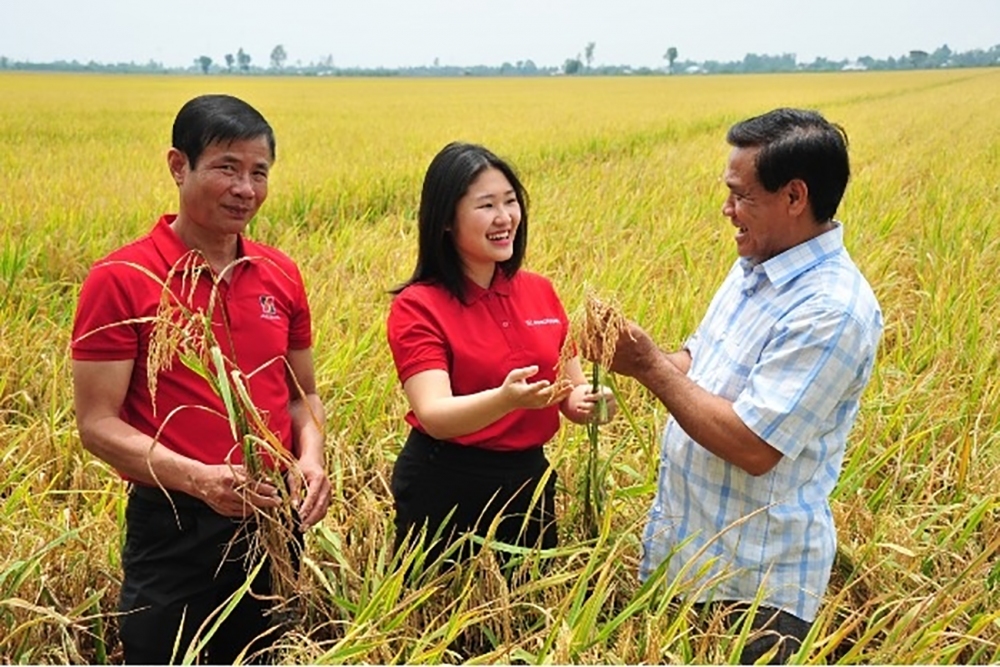chain Loan Model Gains Traction: A Lifeline for U.S. Small Businesses?
April 4, 2025
The Promise of Chain Loans
The “chain loan model” is increasingly viewed as a solution to the financial difficulties faced by many small and medium-sized enterprises (SMEs), offering significant opportunities for both lenders and borrowers. this approach aims to minimize credit risks and enhance business efficiency by supporting production, consumption, and the creation of robust economic ecosystems. The core concept revolves around lending to businesses within a supply chain collectively, rather than individually, leveraging the strength of the entire chain. Mr. Nguyen Van Than, president of the Association of Small and Medium Vietnam companies, aptly stated that SMEs have “no choice but to join together,” highlighting the collaborative nature of this financing model.
For U.S. businesses, especially those in agriculture and manufacturing, the chain loan model presents a compelling alternative to conventional lending. Imagine a scenario where a local farm,a food processor,and a distributor all work together.A chain loan could provide the necessary capital for each entity to upgrade equipment, expand operations, and ultimately, strengthen the entire supply chain. This is particularly relevant given the current governance’s focus on bolstering domestic supply chains and supporting local economies.
Benefits in the Agricultural Sector
In agriculture,the chain loan model offers unique advantages. As THS. Tran Van tan, a member of the Vietbank Board of Directors, explained, research across five countries revealed that value chain loans enhance “clarity, the management of cash flow, while developing banking products and promotes the role of communities and cooperatives in rural areas.” This is echoed by findings within the U.S. Department of Agriculture (USDA), according to the Food Supply Chain Guaranteed Loan Program which “provides financial support to qualified lenders whose loan applicants want to start or expand.” The chain loan model can facilitate easier access to credit for SMEs through guarantees or loans from larger, more established companies within the chain.
For example, consider a cooperative of dairy farms in Wisconsin. A chain loan could enable the cooperative to invest in new technologies, such as robotic milking systems, while simultaneously providing financing to a local cheese factory to expand its production capacity. The loan is structured to benefit the entire chain, ensuring that each member has the resources needed to contribute to the overall success.
Challenges and Past Failures
Despite its potential, the widespread adoption of chain loans faces significant hurdles. The primary challenge lies in effectively linking the various components of the chain. Dao minh Tu,the permanent vice governor of the State Bank of Vietnam,pointedly noted that a previous attempt to implement 21 value chain linking models failed due to a lack of guaranteed benefits for all participants.The Vice Governor’s analysis emphasizes “Bank loans throughout the chain without demanding guarantees can bring many benefits to the parties involved in the chain, companies, economics and commercial banking. Tho, the success of this model depends largely on the close coordination between the components of the chain.”
The failure of past initiatives underscores the importance of careful planning and execution. A prosperous chain loan requires a strong foundation of trust and cooperation among all participants.If the connection is weak, the entire structure can collapse. In the U.S. context, this means that lenders need to conduct thorough due diligence to ensure that all members of the chain are financially stable and committed to the project’s success.
A potential counterargument to chain loans is that they can create dependencies within the supply chain. if one member of the chain fails, it could have a ripple affect on the others, jeopardizing the entire loan. This risk can be mitigated through diversification, insurance, and robust risk management strategies.
A Pilot Program Success
There have been successes. A two-year pilot program focusing on high-quality rice production in the Mekong Delta demonstrated that chain loans can be highly effective when all parties are fully engaged. The positive results from this program highlight the potential for replicating this model in other sectors. The banking sector is eager to continue developing this approach, recognizing its potential to benefit a wide range of companies.
This success can be mirrored in the U.S.. Imagine a community-supported agriculture (CSA) program receiving a chain loan to improve farming practices and expand its membership base. The loan could be structured to support the farmers, the delivery service, and the marketing efforts, creating a sustainable and thriving local food system.
Bank Initiatives and Strategies
Several banks are already proactively implementing chain loan models, with Agribank leading the way with its focus on key agricultural products. According to Mrs.Phung Thi Binh, deputy general director of Agribank, the bank is “ready to lend in chain, becuase this is an effective loan model, especially for small -scale SMEs whose management capacity is not yet adequate and that they must be linked and supported by each other to develop and expand productive and commercial activities.”
In the U.S., several regional and community banks are exploring similar strategies. These banks recognize the importance of supporting local businesses and strengthening supply chains. By offering chain loans, they can play a critical role in fostering economic growth and creating jobs in their communities.
For example, the Bank of America offers specialized lending programs to small businesses, and other banks may follow suit. These programs could be adapted to incorporate the chain loan model, providing targeted financial assistance to businesses within specific industries or regions. In addition, the Small Business Administration (SBA) offers loan guarantee programs that could be used to support chain loans, reducing the risk for lenders and making it easier for SMEs to access capital.
Improving Access to Capital
A key element in the successful growth of chain loans is improving customer access to capital. This includes reducing stringent mortgage conditions and increasing credit availability. One bank leader has stated that their institution is actively examining the links within chains and is “willing to reduce the guarantee conditions for the chain participants.”
In the U.S.,this could involve streamlining the loan request process,reducing collateral requirements,and offering more flexible repayment terms. Banks could also partner with community development financial institutions (CDFIs) to provide technical assistance and financial education to SMEs, helping them to become more creditworthy.
The Role of Associations
Associations play a crucial role in bridging the gap between companies and banks. Mr. Nguyen Van Than suggests that associations should act as “a representative role, both presentation and bridge, connecting companies with banks.” He also emphasizes that “through good reputation associations, banks also have more security when lending in chain.”
For U.S. businesses, organizations such as the National Federation of Self-reliant Business (NFIB) and the U.S. Chamber of Commerce could play a similar role. These groups could work with banks to develop standardized loan products, provide training and resources to SMEs, and advocate for policies that support chain lending. Moreover, industry-specific associations, such as the National Restaurant Association or the National Association of Manufacturers, could tailor chain loan programs to meet the unique needs of their members.
Conclusion: A Promising Path Forward
The chain loan model holds significant promise for U.S. small businesses. While challenges remain, the potential benefits—increased access to capital, stronger supply chains, and enhanced economic development—are undeniable. By learning from past failures, embracing collaboration, and fostering innovation, the U.S.can unlock the full potential of chain loans and create a more vibrant and resilient economy. The association is willing to cooperate with organizations such as accounting associations and banks to promote this loan modality and ensure its efficient,equitable implementation.
Could chain loans be a viable solution for small businesses struggling to secure customary financing?
Chain loan Model: A Powerful Tool for U.S. Small Businesses? An Interview with Expert,Eleanor vance
April 4,2025
Archyde News: Eleanor,welcome to Archyde News. we’re eager to delve into the emerging chain loan model and its implications for U.S. small businesses. To start, could you briefly explain what chain loans are and why they are attracting attention in the current economic climate?
Eleanor Vance (Senior Loan Analyst at Sterling National Bank): Thanks for having me. Chain loans,in essence,are a collaborative financing approach. Instead of lending to individual businesses, the model focuses on lending to an entire supply chain, such as a farm, a food processor, and a distributor, leveraging the collective strength of the chain. Given the current focus on bolstering domestic supply chains and supporting local economies, it’s gaining traction as a potentially more accessible funding source for SMEs.
Chain Loans in agriculture and Manufacturing
Archyde News: The agricultural sector, and indeed manufacturing, seems like a natural beneficiary. Can you elaborate? What specific advantages do chain loans offer in these industries?
Eleanor Vance: Absolutely. In agriculture, for example, a chain loan could facilitate a cooperative of dairy farms investing in new technologies, like robotic milking systems, while also assisting a local cheese factory with expanding production. This approach fosters cash flow management and the development of rural communities. Similarly, in manufacturing, it allows all members of the chain to upgrade equipment, expand operations, and ultimately strengthen the entire production process.
Addressing the Challenges
Archyde News: We understand that challenges exist. What are the primary hurdles to the widespread adoption of the chain loan model, and how can these be addressed?
Eleanor Vance: The biggest challenge is effectively linking all the components within the supply chain. A weak link can jeopardize the entire loan. Thorough due diligence from lenders to ensure participants’ financial stability and commitment is crucial.Also, diversification and strong risk management strategies are key to mitigate the impact of any one entity failing. Addressing trust and information asymmetry is vital as well.
SBA Loan Programs and Government Support
Archyde News: The Small Business Administration (SBA) is mentioned in this context. How could existing SBA loan programs support or be adapted to facilitate chain loans?
Eleanor Vance: The SBA 7(a) loan program and other initiatives can be quite helpful. They could provide guarantees or loans to reduce risk for lenders. This would increase the likelihood of SMEs,particularly in agriculture and manufacturing,gaining access to capital. There’s also the potential for SBA programs to be directly tailored to support chain lending structures.
The Role of Associations
Archyde News: Associations seem to play an important supporting role. How can industry-specific and national organizations contribute to the success of chain loans?
Eleanor Vance: Associations, like the National Federation of Self-reliant Business (NFIB) or the U.S. Chamber of Commerce, have a notable role in bridging the gap between businesses and banks. They can work with banks to develop standardized loan products, offer training and resources to SMEs, and advocate for policies that encourage chain lending.
Looking Ahead
Archyde News: What do you see as the long-term potential of chain loans for U.S. small businesses, and what steps should be taken to ensure their accomplished implementation?
Eleanor Vance: In the long term, chain loans could unlock significant benefits, including increased access to capital and stronger supply chains.To ensure success, we must learn from past failures, embrace collaboration among all the stakeholders and foster innovation. Streamlining the loan request processes, reducing collateral requirements, and offering flexible repayment terms are some measures which would help promote their adoption and success.
Archyde News: Eleanor, thank you very much for your insights today. It’s been illuminating.
Eleanor Vance: My pleasure.
Archyde News: We’d love to hear our readers’ thoughts: Do you think chain loans could be a game-changer for small businesses struggling to secure financing? Share your opinions in the comments below!








